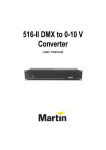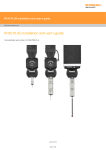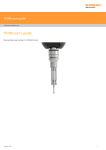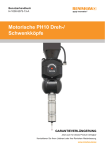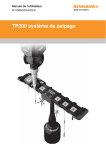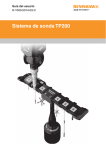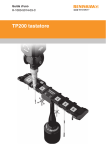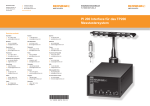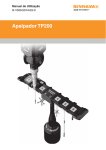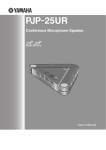Download Renishaw H-1000-5071-09-A Installation guide
Transcript
Installation guide H-1000-5029-05-B PI 200 interface for the TP200 system © 2002 - 2007 Renishaw plc. All rights reserved. Renishaw® is a registered trademark of Renishaw plc. This document may not be copied or reproduced in whole or in part, or transferred to any other media or language, by any means, without the prior written permission of Renishaw. The publication of material within this document does not imply freedom from the patent rights of Renishaw plc. Disclaimer Considerable effort has been made to ensure that the contents of this document are free from inaccuracies and omissions. However, Renishaw makes no warranties with respect to the contents of this document and specifically disclaims any implied warranties. Renishaw reserves the right to make changes to this document and to the product described herein without obligation to notify any person of such changes. Trademarks All brand names and product names used in this document are trade names, service marks, trademarks, or registered trademarks of their respective owners. Renishaw part no: H-1000-5029-05-B Issued: 10 2007 PI 200 interface for TP200 probe system installation guide FCC Information to user (FCC section 15.105) This equipment has been tested and found to comply with the limits for a Class A digital device, pursuant to Part 15 of the FCC rules. These limits are designed to provide reasonable protection against harmful interference when the equipment is operated in a commercial environment. This equipment generates, uses, and can radiate radio frequency energy and, if not installed and used in accordance with the instruction manual, may cause harmful interference to radio communications. Operation of this equipment in a residential area is likely to cause harmful interference, in which case you will be required to correct the interference at your own expense. Information to user (FCC section 15.21) The user is cautioned that any changes or modifications not expressly approved by Renishaw plc or authorised representative could void the user’s authority to operate the equipment. Special accessories (FCC section 15.27) The user is also cautioned that any peripheral device installed with this equipment such as a computer, must be connected with a high-quality shielded cable to insure compliance with FCC limits. TÜV This equipment has been independently certified by TÜV Product Services in accordance with OSHA (US) and SCC (Canada) requirements to the standards UL61010-1 Second Edition and CAN/CSA-C22-2 No. 61010-1 Second Edition. Care of equipment Care of equipment Your Renishaw probe and accessories are precision instruments. Please use and maintain the products in accordance with these instructions. Retain the transit box for storing the components when not in use. ! CAUTION: The TP200 probe contains sensitive strain sensors. Permanent damage may be caused if the probe is dropped or subjected to severe shock as may be caused by misuse. Changes to Renishaw products Renishaw plc reserves the right to improve, change or modify its hardware or software without incurring any obligations to make changes to Renishaw equipment previously sold. Warranty Renishaw plc warrants its equipment provided that it is installed exactly as defined in associated Renishaw documentation. Consent must be obtained from Renishaw if non-Renishaw equipment (e.g. interfaces and/or cabling) is used or substituted. Failure to comply with this will invalidate the Renishaw warranty. Claims under warranty must be made from authorised services centres only, which may be advised by the supplier or distributor. Patents Aspects of the TP200 system and aspects of similar systems are the subjects of the following patents and patent applications: EP 0243766 EP 0388993 EP 242747 B EP 279828 B EP 0470234 EP 0521703 EP 548328 B EP 566719 B EP 0501710 EP 0641427 EP 0392660 EP 0740768 JP 2,545,082 JP 2,539,824 JP 2,647,881 JP 3,004,050 JP 3,346,593 JP 3,294,269 JP 3,279,317 JP 2,510,804 JP 3,634,363 JP 3,018,015 JP 3,546,057 US 4813151 US 4817362 US 4916339 US 5,228,352 US 5,327,657 US 5,404,649 US 5,339,535 US 5,323,540 US 5,505,005 US 5,671,542 US 4769919 US 5,088,337 US 5,755,038 US 5,918,378 US 6012230 WO 97/35164 Safety Safety If this product is not used in its intended manner, any protection provided may be impaired. There are no user serviceable parts inside this equipment. The PI 200 interface unit must be connected to a supply incorporating a protective earth conductor via a three-core mains cable (line cord). Electrical ratings Supply voltage range Power frequency range 100 - 240 V ac + 10%, -15% 47 Hz - 63 Hz Power consumption 10 W SSR contact ratings ±50 V pk. ±40 mA pk. Operating conditions The PI 200 interface unit is specified to operate under the following conditions as defined in BS EN 61010-1:2001. Protection provided by enclosure Altitude Operating temperature Storage temperature Relative humidity Transient overvoltage Pollution degree IP30 Maximum 2000 m 0 °C to +50 °C -10 °C to +70 °C Maximum 80% RH up to +31 °C, decreasing linearly to a maximum 50% at +40 °C. Installation category II 2 The PI 200 is isolated from AC power by disconnection of the IEC mains connector on the rear panel. If any additional means of isolation is required, it must be specified and fitted by the machine manufacturer or the installer of the product. The isolator must be sited within easy reach of the CMM operator and comply with IEC61010 and any applicable national wiring regulations for the country of installation. Contents Contents 1 Introduction.................................................................................................................7 2 Product description.....................................................................................................9 2.1 System overview.............................................................................................9 2.2 Probe status signal (SYNC).............................................................................9 2.3 Trigger confirmation signal (HALT)................................................................10 2.4 SYNC and HALT debounce...........................................................................12 2.5 Probe damped signal (PDAMP)....................................................................13 2.6 Stylus mass and ambient temperature compensation...................................14 2.7 RESET button................................................................................................14 2.8 Front panel indicators....................................................................................15 2.9 Audible indicator............................................................................................16 2.10 Rear panel switches and connectors.............................................................16 2.11 Configuration switches..................................................................................17 2.12 Probe polarity switch.....................................................................................21 3 Connector pin-outs...................................................................................................22 3.1 PICS input connector.....................................................................................22 3.2 PICS output connector..................................................................................23 3.3 Solid state relay (SSR) output connector......................................................24 3.4 Stylus change rack (SCR) output connector.................................................25 3.5 Remote reset.................................................................................................25 4 PI 200 dimensions and cable data............................................................................26 5 Part number summary..............................................................................................27 5.1 Replacements................................................................................................28 5.2 Accessories...................................................................................................28 6 Installation procedure...............................................................................................29 6.1 Rack mounting...............................................................................................29 6.2 Mounting with older style Renishaw control units..........................................30 6.3 System interconnection.................................................................................31 6.4 Using TP200 with the ACR1 autochange system..........................................36 6.5 SCR200 stylus change rack..........................................................................37 6.6 Interconnection cables...................................................................................38 6.7 Upgrading older probe systems to TP200 (retrofitment)................................39 Contents 7 PICS terminations.....................................................................................................40 8 Summary of changes from earlier versions..............................................................41 9 Maintenance.............................................................................................................42 9.1 PI 200............................................................................................................42 9.2 TP200 probe and stylus module....................................................................42 9.3 SCR200 rack.................................................................................................42 10 Fault finding..............................................................................................................43 Introduction 1 Introduction The TP200 probe system comprises the TP200 probe sensor and stylus module, the PI 200 interface and the optional SCR200 stylus change rack. The TP200 is a 13.5 mm diameter touch-trigger probe with the facility to quickly change stylus configurations without the need for requalification. This is achieved by carrying the stylus on a detachable module that is located on the probe sensor body by a highly repeatable kinematic coupling and held in place by magnetic force. After initial qualification of the stylus tip, the module may be removed and replaced as required without additional requalification by simply recalling the initial qualification data. The probe sensor uses electronic strain sensing techniques that provide better form measuring accuracy and operating life than can be achieved with kinematic switching probes. The SCR200 stylus change rack provides storage for pre-qualified stylus assemblies and facilitates automatic stylus changing under measurement programme control. The dedicated PI 200 interface supplies power and controls the operation of the TP200 probe and SCR200 rack. Communication with other Renishaw equipment and the CMM controller is via the PICS (product interconnection system) ports. The TP200 system components (probe sensor, stylus module, PI 200 interface and SCR200 stylus change rack), illustrated in figure 1, are described in the TP200 probe system user’s guide (Renishaw part number H-1000-5014). A version number label (e.g. V9) on the PI 200 rear panel indicates the modification level of the unit. A summary of the changes made at each level is included later in this document. Introduction SCR200 stylus change rack TP200 probe sensor TP200 stylus module Kinematic coupling PI 200 interface Stylus Figure 1 - TP200 precision touch-trigger probe system Product description 2 Product description 2.1 System overview A small deflection of the stylus tip produces a force which is applied via the stylus module and kinematic coupling to the strain sensing structure housed in the probe body. Electronic processing, based on a customised mixed signal integrated circuit and hybrid microcircuit construction contained within the probe, converts the sensor responses to a current proportional to strain. The probe output requires only two wires for transmission to the PI 200 interface, enabling the TP200 to use the existing M8 mounting connector system fitted to a wide range of probe heads and extension bars. In the PI 200 interface, the probe current is compared with pre-set reference levels to determine the status of the probe, which may be armed (seated) or triggered. The probe status (SYNC) and the trigger confirmation (HALT) signals are asserted when the appropriate conditions are met. At power-up, or when a probe is first connected, the PI 200 recognises whether the probe is a kinematic switching probe (TP20/TP6/TP2 type) or a TP200, and automatically selects the appropriate operating mode. When using the SCR200 change rack to perform automatic stylus changing, the PI 200 inhibits probe triggers and resets the TP200 probe sensor to account for the loading effects of the new stylus assembly on the strain sensors. Collision damage is prevented by an overtravel mechanism and a limit switch in the base of the SCR200. A small displacement will cause the PI 200 to assert the SYNC, HALT and STOP signals to stop CMM motion. 2.2 Probe status signal (SYNC) SYNC is the real time PICS trigger signal used to trigger recording of the machine scale coordinates when taking a gauge point. SYNC may also initiate the process of stopping and reversing CMM motion (sometimes called ‘back-off’) to the pre-hit point. When the stylus contacts the workpiece, a change of strain occurs in the sensing structure, causing the probe current to increase. SYNC is asserted when the probe current exceeds the trigger reference level. When the stylus backs off from the workpiece, the probe current will fall below the trigger reference level and SYNC will be cleared to the armed state. 10 Product description The timing relationships for an idealised probe signal are indicated in figure 2. A solid state relay (SSR) output is provided which mimics the PICS-SYNC output for connection to older CMM controllers that require voltage-free contacts to simulate the trigger signal of a kinematic switching probe. 2.3 Trigger confirmation signal (HALT) To allow the CMM controller to distinguish between a valid trigger and a spurious trigger caused by vibration or shock, a trigger confirmation signal (HALT) is provided on the PICS port. HALT will be asserted if the probe current remains greater than trigger level 2 for a pre-set delay time, determined by the settings of configuration switches 11 and 12. The timing relationships for an idealised TP200 probe signal are indicated in figure 2. Should the probe current fail to reach the trigger level or drop below the reseat level before the delay time has expired, as might be the case for a vibration-induced signal, HALT will not be asserted. The CMM controller may then assume the trigger was spurious and reject the coordinate data. When a kinematic switching probe (TP20, TP6, TP1, TP2) is connected, the HALT delay time is fixed at 5 milliseconds as indicated in figure 3. 11 Product description V Probe signal Trigger level 2 and HALT Trigger level 1 t SYNC Debounce times set by switch 6 and switch 7 HALT Delay time set by switch 11 and switch 12 Figure 2 - SYNC and HALT signal timing for a TP200 gauge point V Probe signal Trigger level t SYNC HALT Debounce fixed 20 ms Delay time fixed 5 ms Figure 3 - SYNC and HALT signal timing for a gauge point when a kinematic probe is connected 12 Product description 2.4 SYNC and HALT debounce The SYNC and HALT signals are debounced to prevent spurious triggers occurring as a result of CMM or stylus vibration when the stylus makes contact with or leaves the surface of the workpiece. A range of switch selectable timing options is provided to suit the requirements of different types of CMM. Alternatively, the debounce may be switched off to allow greater flexibility for the CMM’s controller to manage the PICS signals. Refer to the section ‘configuration switches’ for more information on the debounce options. The ‘adaptive’ settings ensure that combinations of CMM vibration and large stylus assemblies do not cause a false indication of probe status during the back-off move. Referring to figure 4, it may be seen that the debounce time increases in increments of either 20 milliseconds or 100 milliseconds until the probe signal remains below the trigger level for one complete timing period. When a kinematic switching probe (TP20, TP6, TP1, TP2) is connected, the debounce times are fixed as indicated in figure 3. V Trigger level t Debounce timer Debounce times set by switch 6 SYNC Figure 4 - Adaptive debounce Product description 13 2.5 Probe damped signal (PDAMP) During high-speed position moves (fast traverse), it is necessary to reduce probe sensitivity to prevent vibration causing unwanted triggers. The CMM controller must assert the PDAMP signal on the PICS port, to switch the PI 200 into the low sensitivity mode known as ‘probe damped’. In this mode, deflection of the stylus will generate SYNC and HALT simultaneously, but only if the probe signal remains above the damped trigger level for longer than the time delay selected by switches 11 and 12 as indicated in figure 5. NOTE: The probe cannot take accurate points when damped mode is active, and the CMM controller must clear the PDAMP signal to return the probe to normal sensitivity before taking a gauge point. It is important that PDAMP is only cleared when vibrations of the CMM and probe stylus have reduced to a sufficiently low level to avoid spurious re-triggering at the end of the position move. Probe damped mode is indicated by an LED on the PI 200 front panel. V Probe signal Probe damped level Trigger level 2 Trigger level 1 t SYNC HALT Delay time set by switch 11 and switch 12 Figure 5 - SYNC and HALT signal timing for a trigger in damped mode 14 Product description 2.6 Stylus mass and ambient temperature compensation In the TP200, probe a reference strain sensor, outside the strain path, adjusts the current in the active strain sensors to provide compensation for slow, uniform, changes of ambient temperature. Fine compensation for thermal drift is provided by a system known as ‘autozero’ that nulls the sensor amplifiers at a slow rate when the probe is armed. Under the control of the PI 200 interface, the autozero automatically switches to a fast rate to reset the probe sensors during a stylus change with the SCR200 change rack or during reorientation of a motorised probe head. When the probe is in the triggered state, the compensation is switched off. If the stylus remains deflected for longer than 10 seconds, drift of the zero reference may occur. The audible warning will sound after this period to indicate that the probe must be reset manually. 2.7 RESET button ! CAUTION: Probe triggers are inhibited when the RESET button is pressed. Before pressing the button, the CMM must be stationary in manual mode with the probe stylus clear of the workpiece. The RESET button on the front panel selects fast autozero to rapidly null the sensor amplifiers. This may be necessary when: 1. The probe does not arm after manually changing the stylus. 2. The audible alarm is sounding a continuous tone to warn that the stylus has been deflected for longer than 10 seconds. NOTE: Alternatively, the probe may be reset by the action of unlocking and locking the PH10T or PH10M motorised head. Refer also to the ‘remote reset’ section. Product description 2.8 Front panel indicators Figure 6 - PI 200 interface front panel Table 1 - Front panel indicators Indicator POWER ON TYPE Colour Function Green Mains power on STD Green Kinematic probe selected TP200 Green TP200 probe selected ON - probe armed (seated) PROBE STOP SEATED Green OFF - probe triggered or no probe connected DAMPED Yellow PICS - PDAMP asserted Red PICS - STOP asserted 15 16 Product description 2.9 Audible indicator The audible indicator has two functions: 1. To provide a brief indication that a probe trigger has occurred. This function may be disabled by configuration switch 5. 2. To warn, by a continuous tone, that the stylus has remained deflected for longer than 10 seconds. The alarm can be cleared by operation of the RESET button on the front panel. Refer to the section ‘Reset button’ for more information on resetting the probe. 2.10 Rear panel switches and connectors Figure 7 - PI 200 interface back panel Product description 17 2.11 Configuration switches CAUTION: Check the PI 200 version number on the rear panel. The switch information in table 2 refers to PI 200 versions V9 or later. Refer to the ‘Summary of changes from earlier versions’ section in this handbook for details of previous revisions. ! All switches are hardware controlled and a change to any switch setting is effective immediately. Table 2 - Configuration switch functions Switch number Function Switch position Description 1 HALT polarity UP DOWN HALT active HIGH HALT active LOW 2 Head LED control UP DOWN External control via PICS LED mimics SYNC 3 STOP disabled UP DOWN PI 200 ignores PICS - STOP STOP asserts HALT/SYNC 4 SYNC polarity UP DOWN SYNC HIGH and SSR closes on trigger SYNC LOW and SSR opens on trigger 5 Audible indicator UP DOWN No beep on trigger Indicator beeps on trigger 6 Debounce time Selects SYNC debounce time Refer to figure 8 7 Debounce mode Selects SYNC debounce mode Refer to figure 8 8 Zero debounce UP DOWN Sets debounce time <2 ms Debounce set by switches 6 and 7 9 Probe signal filter UP DOWN Filter active Filter off 10 Trigger level UP DOWN Trigger level 2 selected Trigger level 1 selected 11 PDAMP/HALT filter delay 12 Coded to select delay time Refer to table 3 18 Product description Switch 1: Inverts the polarity of the HALT output. Switch 2: Selects control of the LEDOFF output to either internal PI 200 control according to the status of SYNC, or sets the output to high impedance for control of the head LED by external switching. Switch 3: Sets the PI 200’s response to STOP when asserted from an external source. When enabled, the PI 200 will assert SYNC, HALT and open the SSR relay. Switch 4: Inverts the polarity of the SYNC and SSR relay outputs. Switch 5: When enabled, a tone will sound for approximately 160 milliseconds when the probe triggers and SYNC is asserted. When disabled, the tone will activate only when the stylus has remained deflected for 10 seconds. Switches 6 and 7: These switches select the debounce time and mode of operation as indicated in figure 8. Switch 8: Overrides the settings of switches 6 and 7, reducing the trigger and reseat debounce times to less than 2 milliseconds. Switch 9: The probe signal filter has a 300 µs time constant to reduce the effects of stylus vibration when the stylus makes contact with the workpiece. Renishaw recommends that this switch is set to the UP position for normal use. 19 Product description V Probe signal Trigger level t SYNC Switch 6 - Down Switch 7 - Down 20 ms SYNC 20 ms adaptive Switch 6 - Up Switch 7 - Down 100 ms SYNC Switch 6 - Down Switch 7 - Up 20 ms SYNC 100 ms adaptive 20 ms Switch 6 - Up Switch 7 - Up 100 ms 80 ms Figure 8 - SYNC debounce options 20 Product description Switch 10: In operating situations where there is an unusually high level of background vibration, it may be necessary to reduce the sensitivity of the TP200 to avoid false ‘air’ triggers. These may occur on some types of CMM when large steel stylus arrangements are used or where the CMM is inadequately isolated from the floor transmission of vibration from nearby machinery or vehicle traffic. Trigger level 1 is the highest sensitivity mode and provides the best measuring performance. Trigger level 2 reduces the vibration sensitivity from level 1 for a small loss of measuring accuracy. ! CAUTION: All stylus tips must be requalified if the trigger level is changed. Switches 11 and 12: To prevent a HALT signal (or HALT and SYNC if probe damped mode is set) from being falsely asserted when the probe is subjected to vibration, a time delay filter is applied. Refer to the description in ‘trigger confirmation signal (HALT)’ section. If a collision occurs at fast traverse speed (i.e. a position move), the filter delay time will incur additional CMM overtravel before motion stops. It is important that the CMM motion can stop within the available overtravel, particularly if collisions can occur directly along the main axis of the probe in the +Z direction. To minimise the overtravel in a collision situation, the filter delay time must be set to the shortest possible time that will prevent ‘air’ triggers from occurring during fast traverse moves when probe damped mode is asserted. Switches 11 and 12 are used to select the nominal filter times indicated in table 3. Table 3 - Function of switches 11 and 12 Time delay Switch 11 Switch 12 2.0 ms DOWN DOWN 7.5 ms DOWN UP 15.0 ms UP DOWN 50.0 ms UP UP Product description 21 2.12 Probe polarity switch The TP200 probe is polarity sensitive and must be connected to the PI 200 such that the centre contact of the M8 connector is positive and the thread is ground (0 V). A reversed polarity connection will cause the POWER and STOP indicators to be illuminated on the front panel. Sliding the switch to the REV position should allow normal operation. Incorrect setting of the polarity switch should not damage the probe. 22 3 Connector pin-outs Connector pin-outs 3.1 PICS input connector The PICS input connector is a 9 pin ‘D’ type socket. The pin numbers are illustrated in figure 9 and their functions are shown in table 4. 5 3 4 9 8 2 7 1 6 Figure 9 - PICS input connector pin numbers Table 4 - PICS input connector Pin number Description 1 STOP 2 PPOFF 3 Ground (0 V) 4 Reserved 5 Probe signal input 6 STOP +5 V pull-up 7 PDAMP 8 LEDOFF 9 Probe signal ground Shell Screen Connector pin-outs 3.2 PICS output connector The PICS output connector is a 9 pin ‘D’ type plug. The pin numbers are illustrated in Figure 10 and their functions are shown in table 5. 1 3 2 6 7 5 4 8 9 Figure 10 - PICS output connector pin numbers Table 5 - PICS output connector Pin number Description 1 STOP 2 PPOFF 3 Ground (0 V) 4 Reserved 5 SYNC 6 HALT 7 PDAMP 8 LEDOFF 9 Not used Shell Screen 23 24 Connector pin-outs 3.3 Solid state relay (SSR) output connector The solid state relay output connector is a 7 pin DIN socket. The pin numbers are illustrated in figure 11 and their functions are shown in table 6. 3 7 5 6 2 1 4 Figure 11 - SSR output connector (view on rear panel) Table 6 - SSR output connector Pin number Description 1 Not used 2 Screen 3 Not used 4 SSR 1 5 SSR 2 6 Not used 7 Not used Shell Screen Connector pin-outs 25 3.4 Stylus change rack (SCR) output connector The SCR200 stylus change rack is connected to the PI 200 via a 6 pin miniature DIN socket. The pin numbers are illustrated in figure 12 and their functions are shown in table 7. Figure 12 - SCR200 output connector (view on rear panel) Table 7 - SCR output connector Pin number Description 1 Reset 2 Fault 3 Inhibit 4 +5 V 5 Ground (0 V) 6 Not used 3.5 Remote reset There are two methods of connection to a remote push button that will achieve the same effect as the RESET button on the front panel of the PI 200 interface. Such a facility may be useful if manual stylus changing is to be frequently used, or if the PI 200 is difficult for the operator to access. A momentary action push button or switch may be connected to pins 1 and 5 on the SCR200 miniature DIN connector on the rear panel. If the connector is already in use for connection of a SCR200 stylus change rack, a dual rack cable type PL97 (refer to table 8, cable no. 11) may be used to provide an additional connector. Alternatively, the button may be directly wired to the PPOFF and ground (0 V) pins (pins 2 and 3) on either of the PICS connectors on the rear panel of the PI 200. 26 4 PICS dimensions and cable data PI 200 dimensions and cable data Dimensions 1/3 rack wide x 2U high 140 mm x 88 mm x 183 mm deep Weight 1.25 kg Mounting method 19 in rack or freestanding Mounting screws M5 x 8 mm maximum penetration Probe voltage (open circuit) 12.4 V Probe cable resistance Max. 5 W/conductor Probe cable length Max. 50 m Wire gauge 0.22 mm2 Part number summary 5 Part number summary PI 200 interface Contents: A-1207-0050 PI 200 interface unit Installation guide Rubber feet (self-adhesive) Rack mounting hardware: 1/3 x 2U blanking panel Rack mounting bracket Link bracket A-1018-0123 A-1018-0124 A-1018-0126 TP200 probe kit - standard force A-1207-0001 TP200 probe kit - low force A-1207-0002 Contents: TP200 probe sensor Stylus module (standard or low force) Tools/cleaning kit Test certificate User’s guide Stylus module - standard force A-1207-0010 Stylus module - low force A-1207-0011 Stylus change rack kit - standard force A 1207-0030 Stylus change rack kit - low force A-1207-0070 Contents: 1 x SCR200 rack 3 x stylus modules (standard or low force) Mounting kit Datuming stylus (PS2R) SCR200 cable - 5 m long (PL63) A-1016-7630 SCR200 cable - 10 m long (PL64) A-1016-7631 SCR200 cable - 20 m long (PL65) A-1016-7632 Dual SCR200 cable adaptor (PL97) A-1016-7660 M12 location piece (for SCR200) M-1371-0298 27 28 Part number summary 5.1 Replacements TP200 probe system user’s guide (English + multilingual CD) H-1000-5014 PI 200 interface for TP200 probe system installation guide (English) H-1000-5029 Cleaning material A-1085-0016 S1 ‘C’ spanner A-1042-1486 S9 double-ended ‘C’ spanner A-1047-3932 S7 M2 stylus pin spanner M-5000-3540 Hexagon key 1.5 mm AF P-TL03-0150 Datuming stylus (PS2R) A-5000-3603 Rubber feet (for PI 200) P-FE01-0003 5.2 Accessories Refer to ‘Probing systems for coordinate measuring machines’ (Renishaw part number H-1000-5050) for details of the available range of probe heads, extension bars and other accessories. High performance GF stylus kit A-5003-2310 Autojoint to M8 adaptor: PAA1 A-1051-0417 Rotary adjustment module: M8 - M8 A-1047-7022 Rotary adjustment module: autojoint to M8 A-1051-0679 Module storage rack for manually operated stylus changing applications: MSR1 (wall mounted) A-1371-0330 MSR1 (CMM table mounted) A-1371-0347 Installation procedure 6 29 Installation procedure ! WARNING: Ensure the PI 200 is disconnected from the mains supply during installation. ! WARNING: Take care not to exceed the operation ambient of 50 °C around the unit. Do not install near sources of heat. Forced cooling may be required in final installation. 6.1 Rack mounting The PI 200 may be mounted in a standard 19 in equipment rack either alone or alongside a Renishaw controller as indicated in figures 13 and 14. R PROBE INTERFACE POWER ON TYPE STD PROBE RESET TP200 SEATED DAMPED STOP A-1018-0123 Figure 13 - Mounting the PI 200 To mount the PI 200 as indicated in figure 13 requires 2 x 1/3 blanking panel kits (part number A-1018-0123). Remove the blanking plugs from both sides of the PI 200 and fit the panels using the M5 x 6 mm long screws provided. Figure 14 - PI 200 with PHC10-2 To mount the PI 200 adjacent to a Renishaw controller, as indicated in figures 14 and 15, the following parts are required: • Rack mounting bracket - part number A-1018-0124 • Enclosure link bracket - part number A-1018-0126 30 Installation procedure Figure 15 - Mounting the PI 200 adjacent to the Renishaw PHC10-2 Remove the blanking plugs from the sides of each unit. Separate the halves of the link bracket and screw them to the interface/controller units, using the M5 x 6 mm long screws provided. Bring the units together and screw the brackets together. Screw the rack mounting brackets to the free ends of each unit and assemble into the equipment rack. 6.2 Mounting with older style Renishaw control units To fit the PI 200 into an existing installation adjacent to an older style PHC10 or ACC2 (with extruded aluminium side panels), a link bracket (part no. M‑1018-0097) and 2 × M5 × 6 mm long screws (part no. P-SC29-0506) are required. Remove the blanking plugs from the sides of the PI 200 and screw the bracket in place. On the older style enclosure, prise out the rubber cover from the corner moulding and loosen the two screws at the top and bottom of the moulding. Locate the bracket between the corner moulding and the unit’s front panel, tighten the screws and replace the rubber cover. Fit the rack mounting bracket to the other end of the PI 200 and assemble into the equipment rack. Installation procedure 6.3 System interconnection Interconnection diagrams for the most common product combinations are given in figures 16 - 21. The standard interconnection cables are listed in table 8. Contact Renishaw for other cable lengths, cable specification or special configurations. Consult the appropriate product installation guide for information about setting the configuration switches of the PHC10-2 or ACC2-2 system controllers: • PH10 series installation guide - part number H-1000-5071 • Autochange system installation guide - part number H-1000-6010 Cable 2 PI 200 Cable 1 MH8 TP200 PICS output CMM controller Figure 16 - System interconnection - MH8 head 31 32 Installation procedure Cable 2 PI 200 Cable 1 0 MIH PAA1 adaptor PICS output CMM controller TP200 Figure 17 - System interconnection - MIH head Cable 4 PHC10-2 Cable 3 PH10T TP200 Cable 5 Communications to CMM controller PICS output CMM controller PI 200 SCR200 Cable 6 Figure 18 - System interconnection - PH10T head Installation procedure Cable 4 PHC10-2 Cable 3 V. 1 PH10M PAA1 adaptor 10 RS 232 HCU Serial MADE IN UK OUTPUT PICS OUT 11 Cable 5 14 HEAD 15 18 Communications to CMM controller TP200 PICS output CMM controller PI 200 SCR200 Cable 6 Figure 19 - System interconnection - PH10M head 33 34 Installation procedure Cable 4 PHC10-2 Cable 3 PH10M Cable 7 PAA1 adaptor Cable 8 SP600M TP200 Communications to CMM controller SP600M PI 200 AC2 Cable 9 Cable 10 Communications to CMM controller ACC2-2 To ACR1 rack PICS output CMM controller Figure 20 - System interconnection - SP600M scanning probe and autochange Installation procedure Cable 4 PHC10-2 Cable 3 PH10M Cable 7 PAA1 adaptor Cable 8 TP7M Communications to CMM controller TP200 PI 200 Cable 5 PI 7-2 Communications to CMM controller ACC2-2 To ACR1 rack PICS output CMM controller Figure 21 - System interconnection - TP7M touch-trigger probe and autochange 35 36 Installation procedure 6.4 Using TP200 with the ACR1 autochange system 105 A 0 Figure 22 - Shock absorbing pad fitted to PH10M The CMM controller must assert the probe damping signal (PDAMP) on the PICS port when the probe is approaching the rack, to prevent a false trigger being generated when the probe contacts the docking port lid. If this is not possible, a shock absorbing pad (part number A-1085-0294 supplied with ACR1) must be fitted to the autojoint connector on the probe head at the point of contact with the port lid. Refer to figure 22. 37 Installation procedure 6.5 SCR200 stylus change rack The miniature DIN connector on the base of the SCR200 rack is connected to the ‘SCR200’ connector on the PI 200 rear panel using cable PL63/PL64/PL65 according to the length required. Refer to table 8, cable number 12. For applications requiring two racks, a dual rack splitter cable is needed. Refer to table 8, cable number 11 and figure 23. The dual SCR200 adaptor cable must be fitted at the PI 200 end. PI 200 SCR200 Cable 12 Cable 12 SCR200 Figure 23 - Connection of dual SCR200 stylus change racks Refer to the ‘TP200 and SCR200 user’s guide’ (Renishaw part number H‑1000-5014) for information on setting up and operating the SCR200 rack. 38 Installation procedure 6.6 Interconnection cables Table 8 - Interconnection cables Cable number 1 2 3 4 5 6 7 Cable ident. Length (m) Part number Notes PL1 0.26 - 0.71 A-1016-0004 Coiled PL2 0.41 - 1.27 A-1016-0006 Coiled PL3 0.68 - 2.32 A-1016-0012 Coiled PL4 4.5 A-1016-0001 Plain PL27 0.225 A-1016-6370 Coiled PL29 0.74 A-1016-6420 Coiled PL22 0.4 A-1057-0131 PL5 0.40 - 0.80 A-1016-0131 Coiled PL6 0.80 - 1.60 A-1016-7673 Coiled PL12 0.10 A-1016-7674 Plain PL13 0.10 - 0.20 A-1016-7675 Coiled PLM6 6 A-1016-7564 Unterminated one end PLM7 4 A-1016-7563 Unterminated one end PLM8 6 A-1016-7677 PLM9 4 A-1016-7678 PL25 0.30 A-1016-0124 PL63 5 A-1016-7630 PL64 10 A-1016-7631 PL65 20 A-1016-7632 PL38 25 A-1016-7625 Unterminated one end PL42 15 A-1016-7624 Unterminated one end PL56 12 A-1016-7626 Unterminated one end PL44 8 A-1016-7627 Unterminated one end PL46 3.7 A-1016-7628 Unterminated one end Unterminated one end PL45 1.8 A-1016-7629 8 PL70 2 A-1016-7634 9 PL76 1 A-1016-7643 Installation procedure 39 Table 8 - Interconnection cables continued Cable number Cable ident. Length (m) Part number 10 PL112 1 A-2172-0004 11 PL97 0.25 A-1016-7660 PL63 5 A-1016-7630 PL64 10 A-1016-7631 PL65 20 A-1016-7632 12 Notes 6.7 Upgrading older probe systems to TP200 (retrofitment) To successfully retrofit a TP200 probe system, the following points will need to be considered: • The CMM controller must service the PICS - PDAMP control signal. Upgrade of the controller may be necessary if this signal is not available. • The probe signal wires from the M8 connector on the probe head must be routed directly to the PI 200 interface. If an in-line interface for kinematic switching probes (TP1/TP2/TP6) is present, it must be removed. • The signal wire resistance must be less than 5 ohms per conductor. • Some experimentation with typical stylus arrangements may be necessary to obtain a satisfactory setting for the PDAMP/HALT filter delay time. The trigger/reseat debounce time and other configuration options will also need to be set. Refer to the ‘configuration switches’ section for more information. • If upgrading from TP2, measurement programs may need to be changed to suit the length of the TP200, which is 5 mm longer than the TP2. • If upgrading from TP2, star or offset (cranked) stylus arrangements will require a minimum 5 mm extension piece to be added for use with the TP200. • If cables other than those supplied by Renishaw are used, equivalent cable screening and connector bonding must be used to maintain compliance with the EMC standards. 40 7 PICS terminations PICS terminations The Renishaw product interconnection system (PICS) has been developed to standardise the format for real-time communications between Renishaw products and the CMM controller. PICS facilitates the integration of multiple probe interfaces and system controllers without the need for additional hardware or software overheads on the CMM controller. Refer to the section ‘connector pin-outs’ for the pin assignments used on the 9 way ‘D’ type PICS connector ports. Refer to figures 16 - 21 in the section ‘system interconnection’ for examples of the PICS connections for typical installations. Note that the order in which the system components are connected is important. In particular, the autochange controller (ACC2-2) should be the last in the chain before the CMM controller (figures 20 and 21) to allow it to disable probe damping (PDAMP) during the ACR1 set-up procedure. Installations incorporating the PI 800-2 probe interface are an exception and the TP800-2 installation guide (Renishaw part number H-1000-5111) should be consulted for further information. For further information, please refer to the PICS installation guide (H‑1000‑5000). Summary of changes from earlier versions 8 41 Summary of changes from earlier versions The table below summarises the changes made from version V7 - V11 as indicated by the label on the rear panel of the PI 200. NOTE: No changes have been made that affect measuring accuracy. Table 9 - Summary of changes from earlier versions Part number Version label Summary of changes PCB layout and component changes due to component obsolescence. A-1207-0050-10 V11 A-1207-0050-09 V10 Layout of rear panel changed and IEC mains connector now unfiltered. Text appearance changed on front panel and RESET button now adjacent to STOP LED. New PLD, mains power supply and 5 V to 15 V dc-dc converter. Functionality identical. A-1207-0050-08 V9 Withdrawn. Additional PDAMP filter delay time option (2.0 ms and 7.5 ms) added. Switches 11 and 12 coded to offer the four delay options. Switch 10 function deleted - now trigger level selector (was switch 11). Mounting brackets removed from kit. PL25 and PL26 cables removed from the top level kit. A-1207-0050-07 V8 Circuit changes to improve immunity to ESD applied to the probe stylus when in TP2 mode. Early reseat, short debounce option (switch 7 UP, switch 6 DOWN) changed from 20/80 ms to 20/20 ms. A-1207-0050-06 V7 Fault corrected that caused fast autozero to latch on if PI 200 was powered up with PPOFF asserted and no TP200 connected. Change to prevent a false audible alarm after a rapid series of soft (low signal level) triggers. 42 9 Maintenance Maintenance 9.1 PI 200 Periodically check the security of mounting screws and electrical connectors. Periodic electrical safety checks should include inspection of the mains cable for damage and safe connections. An earth continuity (ground bonding) test may be applied between the protective earth pin of the mains connector and the metal case at a test current no greater than 25 A. Remove dust from the external surfaces with a proprietary cleaning cloth. 9.2 TP200 probe and stylus module The kinematic coupling mechanism, connecting the probe sensor to the stylus module, incorporates precision ball/V groove seatings. The coupling mechanism has been tested in a wide range of environments and is highly tolerant of non-metallic dust, but regular inspection and cleaning with the material supplied is recommended to ensure continued high performance. Instructions for use are included with the cleaning material (Renishaw part number A‑1085-0016). The user should determine the frequency of cleaning according to the conditions of use. Stylus balls, threads and mating faces should be cleaned with proprietary cloths or solvent. Stylus modules that are not in use should be stored in spare ports in the SCR200 rack or in their transport boxes. 9.3 SCR200 rack Periodic cleaning of the rack ports, lids and outer surfaces using a proprietary cloth is recommended to prevent contamination of the modules. Fault finding 10 43 Fault finding Table 10 - The CMM will not register a probe trigger, but the probe operates normally when the stylus is deflected by hand. PI 200 indicators: ‘STOP’ LED is ON. ‘TP200’ LED is ON. ‘SEATED’ LED operates normally. Checks/remedies Possible cause • The CMM controller or a Renishaw system has activated the STOP signal. • The SCR200 overtravel mechanism is deflected. • Check the status of the Renishaw motorised probe head or other systems. • Check the status of the Renishaw motorised probe head or other systems. Table 11 - The probe fails to trigger and the probe LEDs glow only dimly when the stylus touches the workpiece, but the probe operates normally when the stylus is deflected by hand. PI 200 indicators: ‘SEATED’ LED is ON. Checks/remedies Possible cause • The trigger speed is too slow. • Probe normally to the workpiece surface. • The stylus is too heavy. • Increase the gauging speed. Table 12 - The probe will not arm or the probe does not stay armed when the RESET button is released. The probe LEDs are always OFF. PI 200 indicators: ‘STD’ LED is ON. ‘SEATED’ LED is OFF. Possible cause • The probe sensor is faulty. • The probe wiring is open circuit. Checks/remedies • Remove the probe and test by substitution. • Check the wiring from the probe to the PI 200 interface. 44 Fault finding Table 13 - The probe will not arm or the probe does not stay armed when the RESET button is released. The probe LEDs are always ON. PI 200 indicators: ‘TP200’ LED is ON. ‘SEATED’ LED is OFF. Possible cause • The probe sensor is faulty or has been damaged by a collision. Checks/remedies • Remove the probe and test by substitution. Table 14 - False (‘air’) triggers occur while the CMM is stationary and the probe LEDs flicker. PI 200 indicators: ‘TP200’ LED is ON. ‘SEATED’ LED operates normally. Possible cause • The probe sensor is faulty. • The probe is loose in the probe head. • There is excessive vibration from an external source. • There is excessive vibration from the CMM. Checks/remedies • Remove the probe and test by substitution. • Correctly tighten the probe. • Remove the cause or isolate the CMM. • Check the CMM’s air supply. • Maintain the CMM’s air bearing system. Table 15 - False (‘air’) triggers occur at gauging speed and the probe LEDs flicker. PI 200 indicators: ‘DAMPED’ LED is OFF. ‘SEATED’ LED operates normally. Possible cause Checks/remedies • The stylus is too large or too heavy. • Use stylus arrangements within recommendations. • There is excessive vibration from the CMM. • Check the CMM’s air supply. • Maintain the CMM’s air bearing system. Fault finding Table 16 - False (‘air’) triggers occur at traverse speed and the probe LEDs flicker. PI 200 indicators: ‘DAMPED’ LED is ON. ‘SEATED’ LED operates normally. Possible cause Checks/remedies • The stylus is too large or too heavy. • Use stylus arrangements within recommendations. • There is excessive vibration from the CMM. • Check the CMM’s air supply. • The traverse speed is too high. • Maintain the CMM’s air bearing system. • Reduce the traverse speed. Table 17 - The probe triggers during an SCR200 stylus change. PI 200 indicators: ‘SEATED’ LED operates normally. Possible cause • The SCR200 is not connected to the PI 200. • Incorrect SCR200 operating mode. Checks/remedies • Check the SCR200 indicator lamps. • Reconnect the cable. 45 46 Fault finding Table 18 - There is an unexpected loss of accuracy. PI 200 indicators: ‘TP200’ LED is ON. ‘SEATED’ LED operates normally. Checks/remedies Possible cause • The stylus ball is damaged or dirty. • Clean the stylus ball, or replace and requalify the stylus. • The stylus is too large or too heavy. • Use stylus arrangements within recommendations. • The probe is loose or not correctly assembled. • Check the stylus joints. • The kinematic coupling is damaged or dirty. • Ensure the module is correctly seated and the probe is tight in the probe head. • The gauging speed has been changed. • Inspect and clean the kinematic coupling. • Requalify the stylus tips. • The trigger threshold has been changed. Table 19 - The deflection alarm is active. PI 200 indicators: Audible indicator is ON. Possible cause • The stylus is or was deflected for longer than 10 seconds. Checks/remedies • Move the stylus clear of any obstruction and press the RESET button. • The stylus module was changed manually. Table 20 - TP200 fails to work. PI 200 indicators: ‘STOP’ LED ON. ‘POWER’ LED ON. Possible cause • The M8 bush polarity is incorrect. Checks/remedies • Change the PI 200 probe polarity switch to the opposite state. Renishaw plc New Mills, Wotton-under-Edge, Gloucestershire, GL12 8JR United Kingdom T +44 (0)1453 524524 F +44 (0)1453 524901 E [email protected] www.renishaw.com For worldwide contact details, please visit our main website at www.renishaw.com/contact *H-1000-5029-05-B*


















































